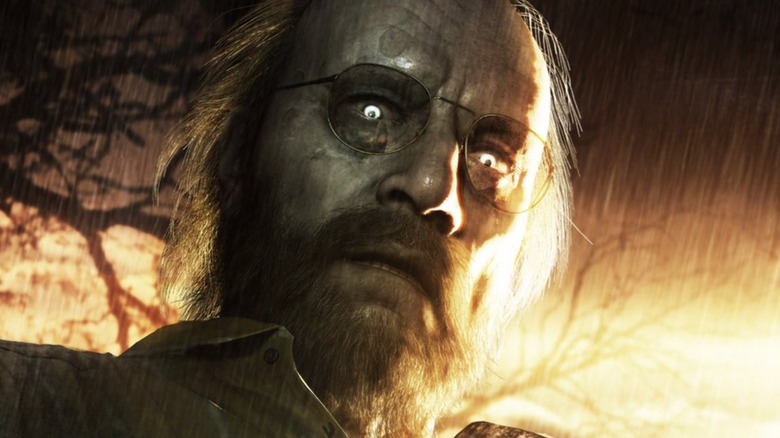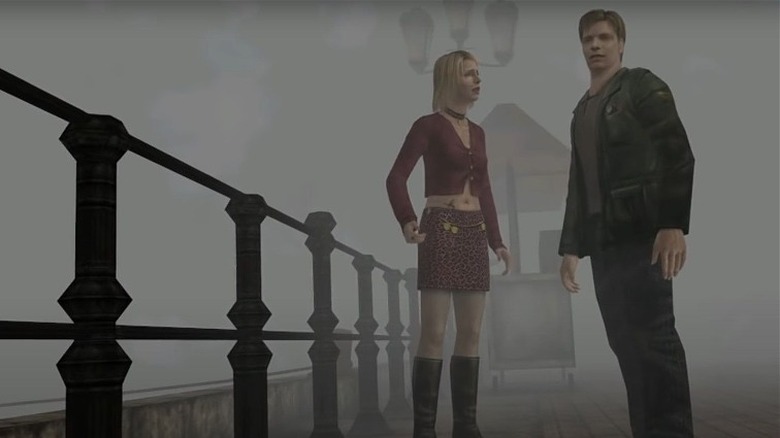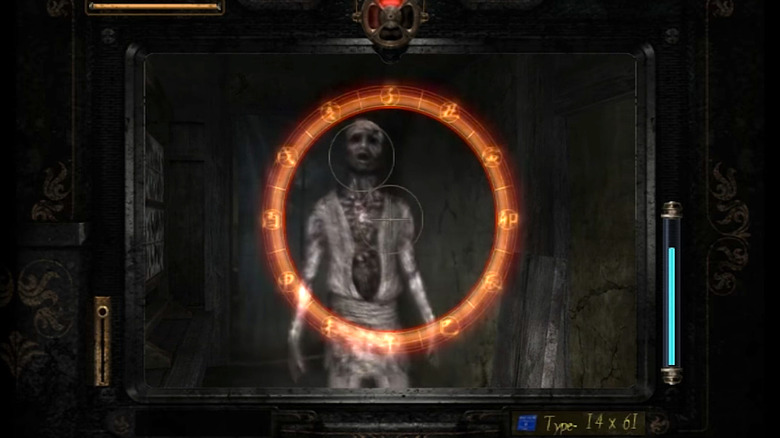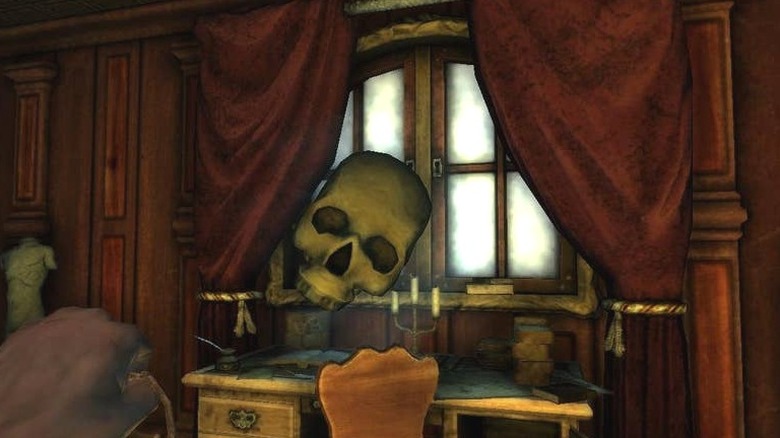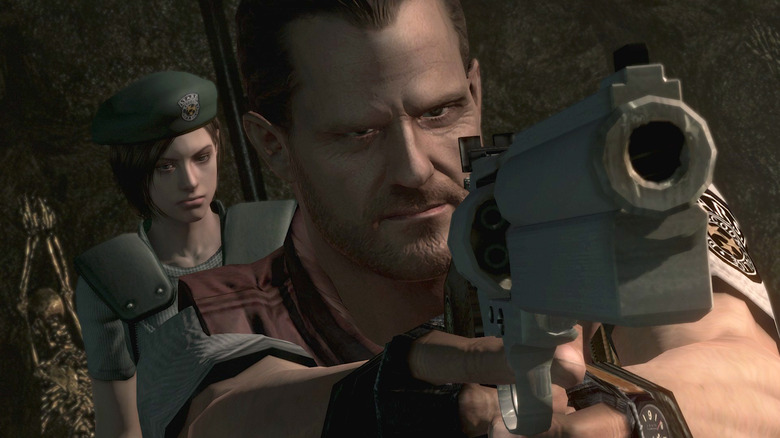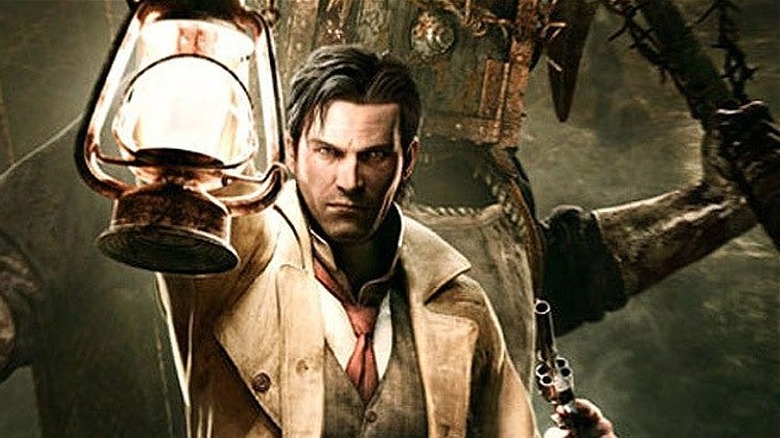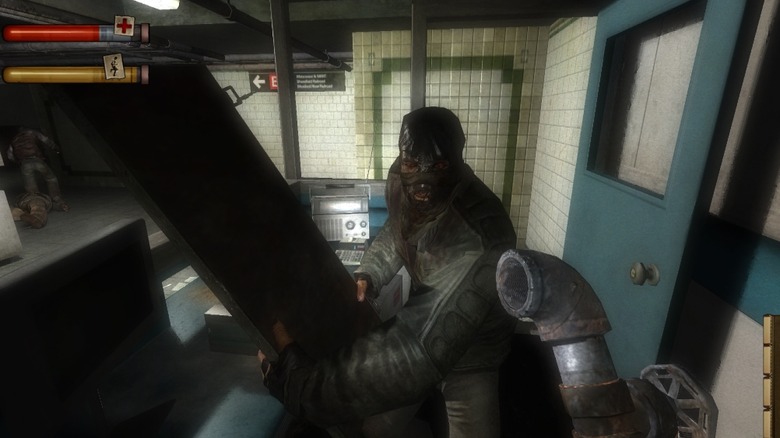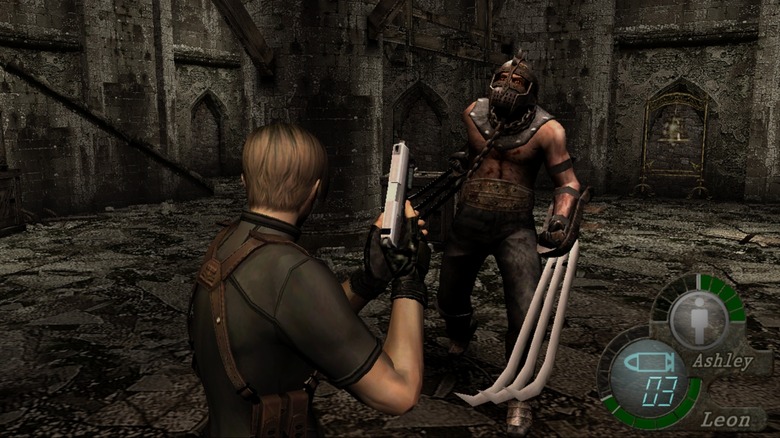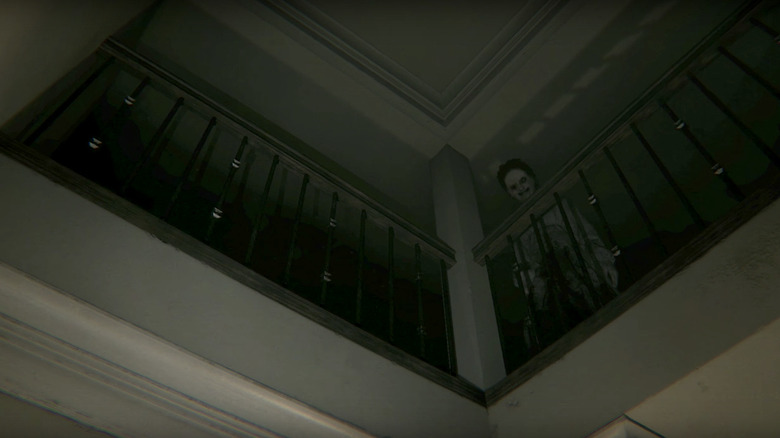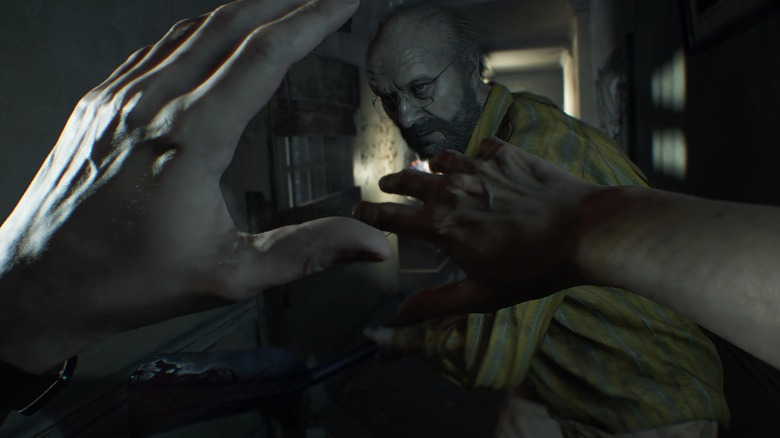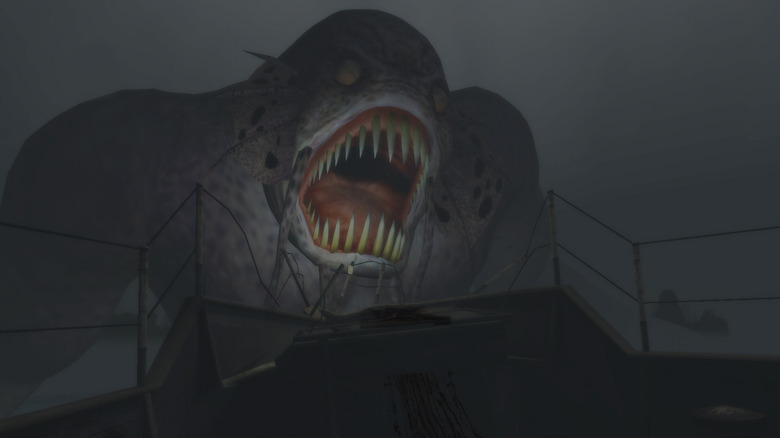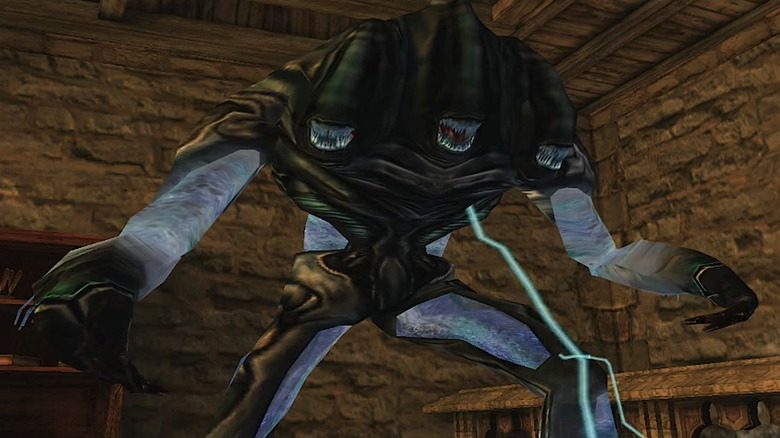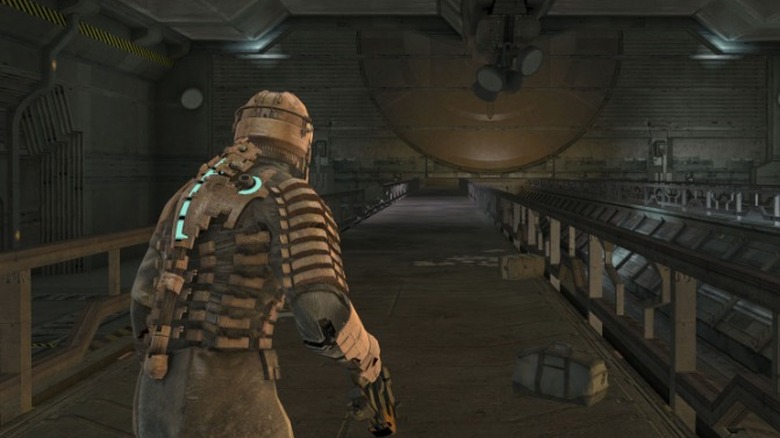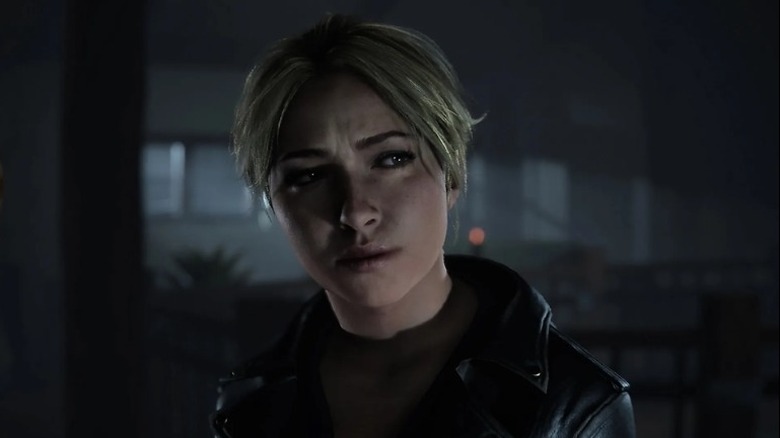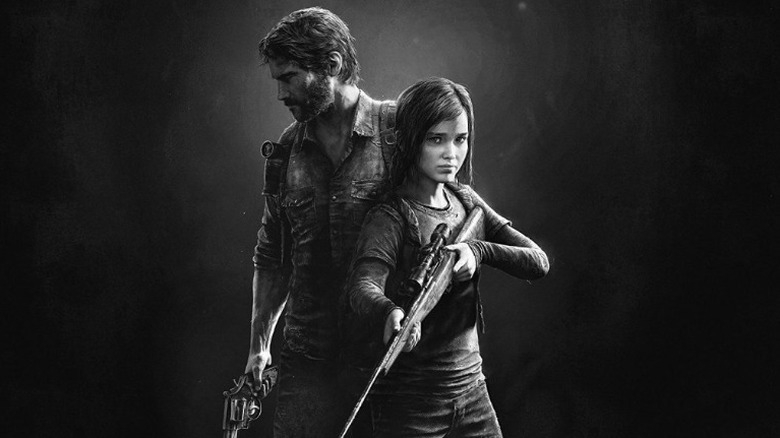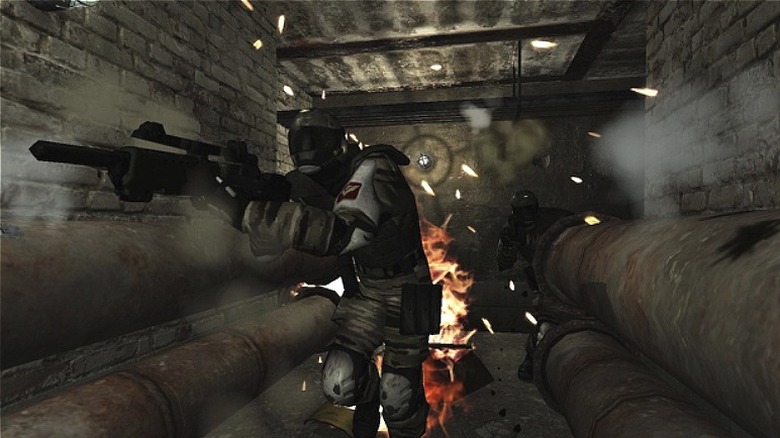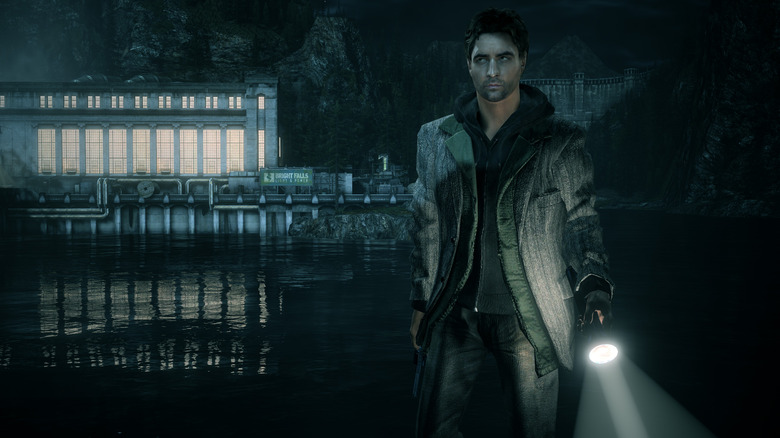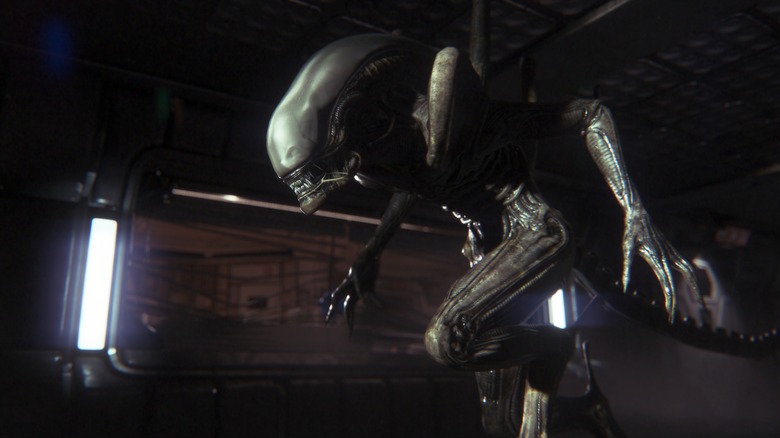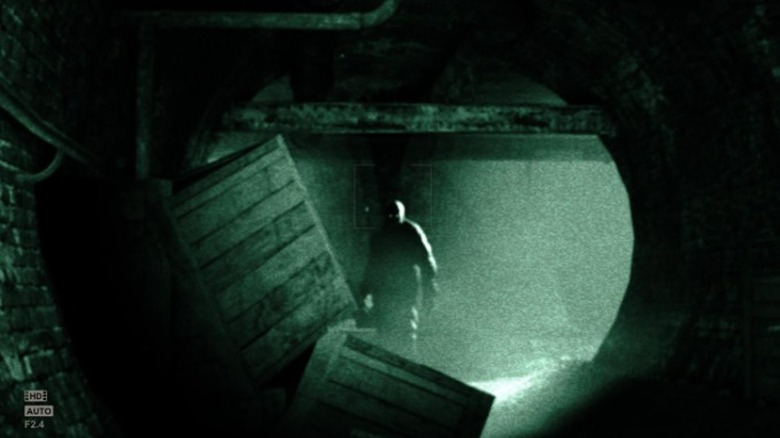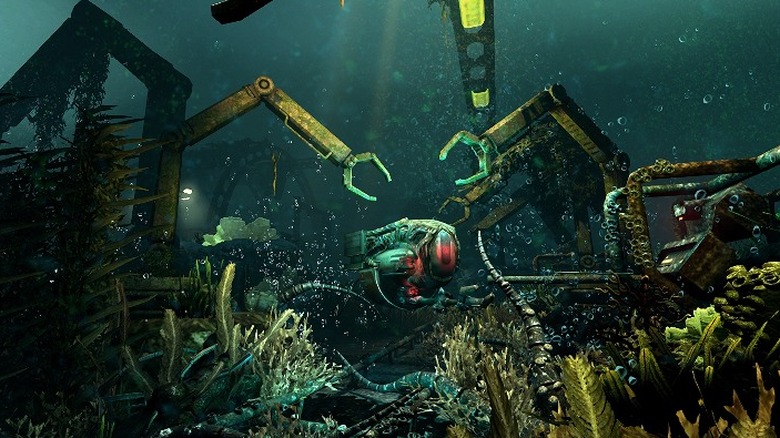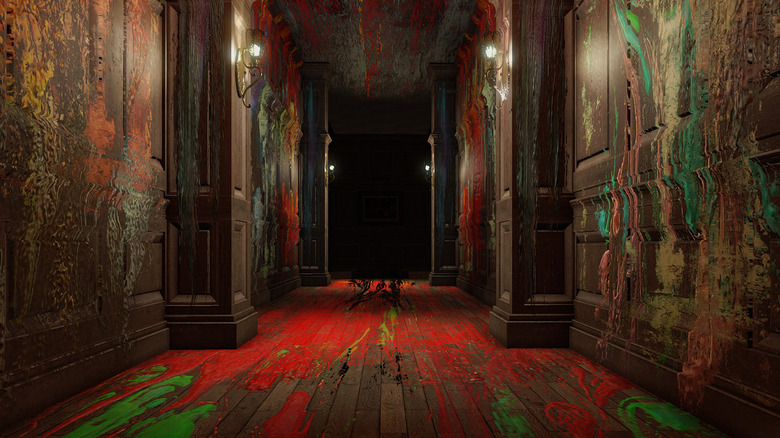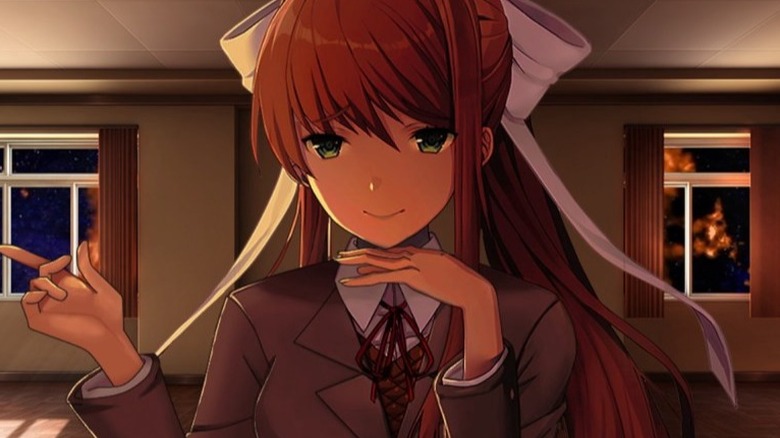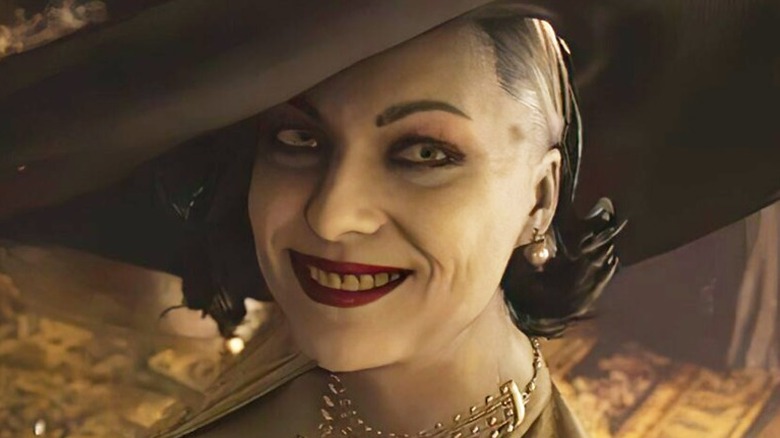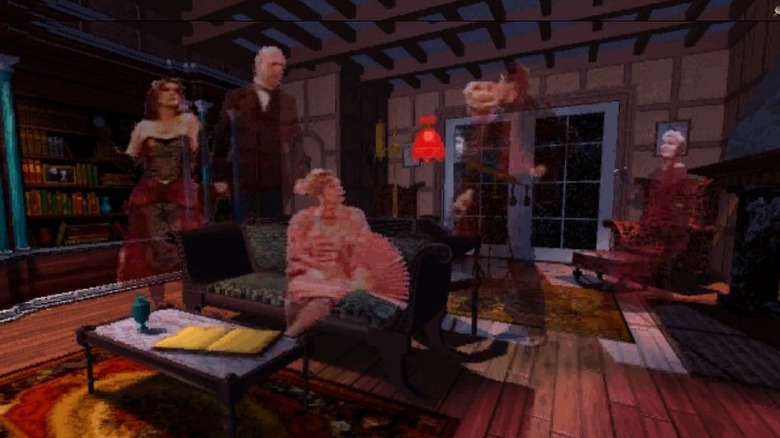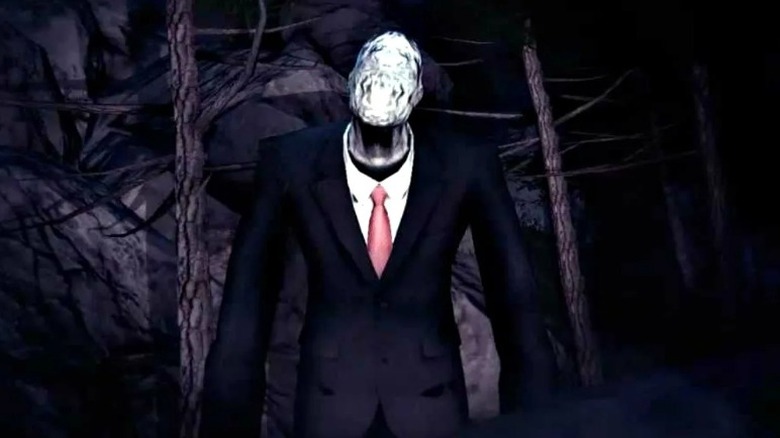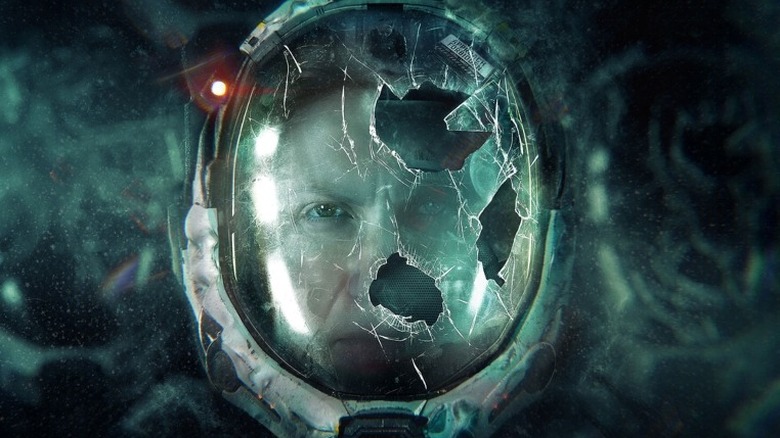The 25 Best Horror Games Of All Time
Whether hunting ghosts in an abandoned Japanese village or slaughtering mutated monstrosities in the dark depths of space, fans of horror gaming will go to great lengths to give themselves goosebumps. And while your local video game store might offer any number of so-called spine-tingling titles, chances are the majority will fail to deliver on the "horror" front.
But fear not: There are plenty of terrifying games, both classic and contemporary, that are bound to get even the gruffest gamers shaking in their pantaloons. Let's take a look at some of the greatest horror games of all time. But beware ... of spoilers!
Silent Hill 2
Heavily influenced by films like "Jacob's Ladder" and "Lost Highway," "Silent Hill 2" — first released for the PS2 in 2001 — ushered in a new era of horror that emphasized psychological terror over undead shufflers and cheap jump scares. The disturbing Konami game centers around everyman James Sunderland, who's armed with only a flashlight, a radio, and a few unimpressive firearms as he ventures through the foggy titular town in search of his apparently not-so-deceased wife.
What made "Silent Hill 2" stand out, however, wasn't its bizarre Lynchian mystery — which ends in one of gaming's most infamous twists — or even its foggy, unwelcoming atmosphere. Rather, it was its use of psycho-sexual motifs, which brought James' most depraved hidden yearnings to life in the form of vulgar, twisted monsters and labyrinthine hellscapes that still has gamers shivering all these years later. And who could forget about the game that introduced Pyramid Head to the world?
- Release Date: Sept. 24, 2001
- Genre: Survival Horror
- Game modes: Single-Player
- Metacritic Score: 89 (PS2)
Fatal Frame 2: Crimson Butterfly
"Fatal Frame 2: Crimson Butterfly"doesn't shy away from J-horror tropes. Creepy dolls, pale-faced ghouls, cursed rituals, and haunted villages — Tecmo's ghostly series borrows heavily from the eerie side of Japanese folklore to deliver a harrowing tale of loyalty and sacrifice.
Players take control of Mio, one half of the twin protagonists, as she and sister Mayu traverse Minakami Village — an abandoned community with a history of performing dark rituals involving twins. With only the Camera Obscura to expel the malicious spirits inhabiting the village, Mio must protect her sister from the spirits of those who've become corrupted by Minakami's "Hellish Abyss." While the first entry in the "Fatal Frame" franchise proved that a captivating ghost story didn't need gargantuan guns or excessive gore, "Crimson Butterfly" managed to perfect the formula by giving gamers a chance to play out a modern-day supernatural fairy tale.
- Release Date: Dec. 10, 2003
- Genre: Action, Horror
- Game modes: Single-Player
- Metacritic Score: 81 (PS2)
Amnesia: The Dark Descent
Memory loss is one of those go-to horror gimmicks the genre just can't seem to shake. When done wrong, it's a cringe-inducing cliché. But, when done right, it can play a pivotal part in driving a morbid narrative home. No modern game better captures this phenomenon than the aptly-named "Amnesia: The Dark Descent." With Lovecraftian influences out the wazoo and a disturbing storyline involving inhumane torture and forbidden rituals, Frictional Games' period piece proved a hit for horror hounds everywhere. It was particularly praised for its atmospheric presentation and its emphasis on maintaining protagonist Daniel's sanity in the face of madness-inducing monsters, an otherworldly entity known as "The Shadow," and the sins of his own vile past.
Perhaps the most terrifying thing of all, though, is the fact that he can't fight back against these strange — and deadly — forces. "Amnesia" doesn't feature a single usable weapon — not one firearm, sword, or even mystical spell. Thus, Daniel's most valuable assets are his own two legs. While the game rewards exploration, both literally and psychologically, it also champions running away when the darkness gets just a little too thick.
- Release Date: Sept. 8, 2010
- Genre: Survival horror
- Game modes: Single-Player
- Metacritic Score: 85 (PC)
Resident Evil and 'REmake'
For all its initial praise, Capcom's survival horror classic "Resident Evil" hasn't exactly stood the test of time. Its graphics, considered groundbreaking 1996, look a bit rough around the edges over two decades later — and those pixelated zombies don't quite inspire fear the way they used to. Still, the granddaddy of digital nightmare fuel had a huge impact on the scene when it was first released for the Sony PlayStation, literally introducing the term "survival horror" into gaming lexicon.
It would only make sense then that Capcom would remake its beloved scarefest for hardware more worthy of its ambitions. Enter "Resident Evil" for the Nintendo GameCube — or, as fans lovingly referred to it, "REmake." Swapping out kitschy live-action cutscenes for fully-rendered CGI and ditching the original game's infamously cringe-worthy dialogue, "REmake" opted instead for photorealistic graphics and a dark, haunting atmosphere. Like its source material, it was met with near universal acclaim, with reviewers noting its unprecedented graphics, bone-chilling ambiance, and heightened spook factor.
- Release Date: March 22, 2002
- Genre: Survival Horror, Third-Person Shooter
- Game modes: Single-Player
- Metacritic Score: 80 (Nintendo Switch), 82 (PC), 83 (PS4), 82 (Xbox One)
The Evil Within
Tango Gameworks' "The Evil Within" isn't about to win any awards in the "best story" category — but that doesn't mean it's not a triumph of the survival horror genre. Combining the beastly abominations from "Resident Evil" with the surreal, gore-strewn settings of "Silent Hill," Shinji Mikami's return to form proves that the godfather of survival horror still has some tricks up his sleeve. The game starts off typically enough: soon after arriving at a brutal crime scene, protagonist Detective Sebastian Castellanos finds himself dropped into a nightmarish realm of hulking beasts and brain-hungry masked maniacs.
But where another game might supply its hero with a bunch of guns and infinite bullets, "The Evil Within" assumes players know what they're doing. In other words, surviving means conserving ammunition, sneaking when necessary, and making a habit of booking it from supervillain Ruvik's overpowered minions. For hardcore survival horror gamers hankering to test their ability to, well, survive horrors, "The Evil Within" is a must-play.
Condemned: Criminal Origins
If the horrific murders and disfigurements committed in "Condemned: Criminal Origins" are any indication, then human beings can be far more terrifying than fictional beasts. Monolith Productions' horror mystery mashup plays like an episode of "CSI" on bath salts, allowing players to flex their forensic muscles using all sorts of nifty tools to uncover the truth behind a series of grisly murders. Of course, the game balances out this brain-work by then forcing protagonist Ethan Thomas into one-on-one beatdowns with a group of sadistic killers. Why the crazed residents of Metro City suddenly want to tear an innocent detective limb from limb is anybody's guess.
Actually, that's a lie — the sequel, "Bloodshot," blames a cult that harnesses the power of sound to pop people's heads like tomatoes. Whatever. "Condemned" is not a game one plays for a cohesive narrative. We'll pretend we understand its cheesy storyline if it gives us another chance to beat on scumbag brutes with pipes, paper cutters, and crowbars. In 2006, IGN called this game "an unforgettable experience," and they're right. There's not a chance you'll forget the sound your 2x4 makes when it connects with an opponent's head.
Resident Evil 4
"Resident Evil 4" is an odd duck. On one hand, Leon's quest to save the president's daughter from Los Illuminados revolutionized the action horror genre with innovative gameplay and intuitive controls. On the other, the action-packed entry scraps the series' tried and true formula, previously defined by pre-rendered backgrounds, "tank-like" movement, and extremely limited ammo. Critics agreed that it handled better than it predecessors, relying instead on a fixed over-the-shoulder camera and aiming mechanic that would become the standard for third-person shooters. It also retained the series' eerie atmosphere, over-the-top puzzles, and creatures who look like they've crawled straight out of players' nightmares.
However, fans of the franchise, while sharing reviewers' enthusiasm, felt that it had stripped the "survival" out of the games that coined the term "survival horror" by providing ample weaponry to dispatch of the mind-controlled Ganados — the game's stand-in for zombies. That said, "Resident Evil 4" is regularly heralded as the series' peak, with re-releases cropping up every few years as new consoles roll out. And there's no denying that it's one of the most replayable entries in the series — who doesn't love mowing down parasite-pulsating freaks with the unlockable Chicago Typewriter?
P.T.
We know, we know: "P.T." isn't exactly a game. It's not even technically a demo. In fact, some critics don't exactly know how to categorize it. But Hideo Kojima's "playable trailer" for his canceled "Silent Hill" reboot, "Silent Hills," was still one of the scariest snippets of gaming glory to come out of 2014. A collaboration between Kojima, director Guillermo del Toro, and horror mangaka Junji Ito, "P.T." saw players exploring a never-ending hallway that grew increasingly disturbing as it looped back to the start. Complete with the creepy ghost of a pregnant lady, a misshapen fetus writhing in the bathroom sink, and hair-raising radio transmissions describing horrific events, "P.T." proved that "Silent Hill" would've been right at home in Kojima's expert hands.
Unfortunately, after Konami's falling out with the video game auteur, the "Silent Hills" project was canceled. In addition, "P.T.," which had already received critical acclaim, was promptly yanked from the PlayStation store, with players who'd previously had the game in their library unable to reinstall it. While it's unlikely we'll ever get the chance to play the game that could have breathed life back into the downward-spiraling series, there's still hope for survival horror purists. Kojima's short-lived "P.T." served as direct inspiration for similar photo-realistic first-person horror games like "Layers of Fear."
- Release Date: Aug. 12, 2014
- Genre: Horror
- Game modes: Single-Player
- Metacritic Score: N/A
Resident Evil 7
While Capcom claims its seventh main installment in the long-running "Resident Evil" series was well into development during the release of Konami's "P.T.," it sure shares a lot in common with Hideo Kojima's ill-fated playable trailer. Enigmatic phone calls, a sense of defenselessness, a dingy house occupied by things that want protagonist Ethan Winters dead — it's all very familiar in the best way possible. But "Resident Evil 7" is more than just a coincidental "P.T." double — it's a harrowing survival horror adventure all its own that at once revitalizes its aging franchise and pays homage to its many thematic traditions, oddly-shaped keys and all.
Harkening back to classic horror films like "The Texas Chain Saw Massacre," "The Ring," and even "Saw," "Resident Evil 7" brings a cinematic scope to the hyper-personal story of Ethan, his missing wife, Mia, and the crazed Baker family. You thought the Licker was scary? Just wait until you get on Jack's bad side.
Call of Cthulhu: Dark Corners of the Earth
Countless video games have taken inspiration from the otherworldly horror literature of H.P. Lovecraft. Fewer have adapted his work directly — and that's a shame. Headfirst Productions' "Call of Cthulhu: Dark Corners of the Earth" proved that the weird-fiction writer's work fits just fine beside contemporary survival horror staples like "Resident Evil" and "Silent Hill." Blending elements of stealth games, shooters, and psychological horror, "Dark Corners of the Earth" is a madness-inducing romp through familiar settings from the Cthulhu Mythos.
"Call of Cthulhu" utilized a number of unique gameplay elements that were considerably advanced for their time, including an absent HUD, with protagonist Detective Jack Walters' health status merely suggested to players by sound cues — like a racing heartbeat or ragged breath — and the screen's color saturation level. Healing meant applying specific remedies rather than cure-all medpacks — for instance, a broken leg would require a splint.
And while surviving the game meant maintaining Walters' physical health, players had to keep his mental health in check too. Gazing upon one too many monstrosities, decrepit corpses, or precarious drops into bottomless abysses could lead to insanity — or a tragic death — followed by a game over. Unfortunately for fans, Headfirst Productions dissolved in 2006, only one year after the release of "Call of Cthulhu."
Eternal Darkness: Sanity's Requiem
Few horror games troll their players as hard as "Eternal Darkness: Sanity's Requiem" did way back in 2002. The Silicon Knights-developed survival horror game didn't sell well — it sold just less than half a million copies worldwide — but it was critically lauded for its unique gameplay, exceptional graphics and sound design, and multi-layered story, which spanned hundreds of years of dark magic. The handful of lucky gamers who've played it will remember it best for its sanity meter, which affected not only the game's 12 playable characters, but you — the player — as well.
If a monster caught sight of your character, your sanity level would drop, resulting in strange visions, environmental anomalies, or spooky phenomena that break the fourth wall. For example, attempting to save one's progress during a moment of insanity might cause the game to pretend to delete all of its save files before flashing white and returning the player safely to the options screen. Alternatively, reloading a firearm after a drop in sanity might cause a character's gun to go off, blowing a hole through their stomach — or tricking players into thinking it did.
"Eternal Darkness" was the first game to play its players, and it's become legendary as a result.
Dead Space
In space, no one can hear you scream — but they can in your living room. Trading in a dusty mansion for a high-tech spaceship, "Dead Space" introduced survival horror gamers to the nightmarish necromorphs, deceased folk mutated back to life by a weird alien infection. Trapped among the necromorphs on the derelict USG Ishimur, protagonist Isaac Clarke must make his way through the mining ship's blood-soaked corridors to survive — and escape — with all of his limbs intact.
Thankfully, Isaac's no stranger to the Plasma Cutter, a versatile gun that slices and dices space-zombies like nobody's business. "Dead Space" took the over-the-shoulder aiming system of "Resident Evil 4" and cranked it up to 11, introducing a new mechanic known informally as "strategic dismemberment." Removing certain limbs slows necromorphs down or even disrupts their means of attack altogether. Of course, Isaac eventually gains access to a whole arsenal of futuristic arms—but none of them are as intuitive as his glorified alien salad chopper.
Until Dawn
If you're a fan of horror movies, then "Until Dawn" is for you. Putting players in control of a typical squad of teens straight out of the cheesiest slasher flick, Supermassive Games' "Until Dawn" entrusts you with the task of flipping horror movie tropes on their heads. Surviving "until dawn" is literally the name of the game as your team avoids getting picked off either by the vicious monsters ... or one another.
While the wrong decisions can result in one or all of your playable characters meeting any number of awful ends, it's also possible to keep each and every main character alive — with some in better shape than others, of course. The game's charm lies in the way it allows players to make the right choices and effectively "beat" a horror movie, proving that day-drinking, party-loving teens may not be as dumb as the movies make them out to be.
- Release Date: Aug. 25, 2015
- Genre: Action, Horror, Narrative
- Game modes: Single-Player
- Metacritic Score: 79 (PS4)
The Last of Us
Winner of countless awards, this critically lauded game proved to be an emotionally taxing, paranoia-inducing assault on the senses when it debuted on the PS3 back in 2013. Joel and Ellie's journey across the post-apocalyptic U.S. in search of a cure for the CBI puts them up close and personal with The Infected, but the zombie-like mutants aren't the only obstacles facing the unlikely pair of survivors. "The Last of Us" offers a rather pessimistic message — namely, that nowhere is safe and nobody can be trusted.
In this overgrown version of America, supplies are limited, everyone and everything is out to get you, and one wrong turn can mean certain death. Naughty Dog's stealth horror title may not pack a whole lot of specific scares, but its terror-inducing sound design, grim outlook, and unforgiving environments do inspire a feeling of constant anxiety that follows the player long after they've put their controller down.
- Release Date: June 14, 2013
- Genre: Action, Horror
- Game modes: Single-Player, Online Multiplayer (Factions)
- Metacritic Score: 95 (PS4)
F.E.A.R.
Don't be fooled by this first-person shooter's brawn-over-brains gameplay — "F.E.A.R." is more than just your bargain-bin bloodbath. Inspired by Japanese horror films like "Ju-On" and "Dark Water," this game's intention isn't to jumpscare players out of their skin. Instead, it aims to crawl underneath and take up residence for a while. In between bouts of blazing, slow-mo bullets, "F.E.A.R." chronicles an investigation into a bizarre string of supernatural phenomena centering around a mysterious girl in a red dress.
Doesn't sound too scary until you realize that the cute little girl skipping around right outside your peripheral vision harnesses the ability to liquify soldiers at will. Alma Wade, the official mascot of the "F.E.A.R." series, is the creepiest li'l monster this side of "The Ring." Needless to say, while "F.E.A.R." received rave reviews for its graphics, sound design, gameplay, and storyline, it was the little psionic ghoul in red that took Monolith Productions' action horror shooter from memorable to unforgettable.
Alan Wake
"Alan Wake" came out in 2005, a result of developer Remedy taking a break to recover from the "Max Payne" crunch. Players control its eponymous author-turned-hero as he searches for his wife in the sleepy Washington town of Bright Falls. But when the events of a novel he doesn't remember writing begin to manifest around him, he soon realizes that such nightmarish events are being perpetrated by a dark presence — named, wouldn't you know it, "The Dark Presence."
What can we say? Ghosts, ghouls, and goblins seem to love chill suburbs. Maybe that's why the shadowy "Taken" populating Bright Falls are so spooky. Remedy's psychological thriller borrows heavily from a pantheon of iconic horror, paying tribute to everything from Stephen King's "The Shining" to David Lynch's "Twin Peaks." The resulting mish-mash of horror tropes, coupled with Remedy's penchant for telling a gripping story, is a cinematic masterpiece that plays out like a full season of TV. "Alan Wake" is undeniably a survival horror mystery for the binge-watching generation.
Alien: Isolation
Set 15 years after the events of the Ridley Scott's horror classic "Alien," "Alien: Isolation" follows Amanda Ripley, daughter of film protagonist Ellen Ripley, as she searches for her missing mother aboard the abandoned Sevastopol Station. Where Sega's previous "Alien" game, "Aliens: Colonial Marines," failed on just about all fronts, "Isolation" is a faithful homage to its cinematic source material — and it more than makes up for its lackluster predecessor by the heck out of players.
Utilizing a noise detection mechanic via an Xbox Kinect, the Xenomorph skulking around the space station is privy to your every breath, gasp, and potato chip crunch, bridging the gap between game and reality — and immersing players in an interstellar nightmare. Of course, this feature can be switched off for the more loud-mouthed — or cowardly — gamers out there, but trial and error is kind of the point of this critically acclaimed galactic gorefest. Either way, the Xenomorph's AI is vicious and unpredictable whether or not it can hear your whimpers, so it's best to tackle this gem in that one pair of pants you were gonna throw out soon anyway.
Outlast
The only thing spookier than a long-forgotten insane asylum is a long-forgotten insane asylum crawling with residents mutated by devious human experiments. Luckily for fans of all things freakish, that's exactly the kind of place where "Outlast" drops its protagonist, investigative journalist Miles Upshur. Wielding only his trusty camcorder, Miles aims to get the scoop on the Murkoff Corporation — a psychiatric organization that's allegedly been abusing their patients at Mount Massive Asylum. Little does he know, however, what awaits him inside of its viscera-splattered halls.
Like many of the greatest horror games, "Outlast" takes a cinematic approach to storytelling — but with a twist. Channeling the "found footage" feel of flicks like "The Blair Witch Project" and "REC," "Outlast" combines a traditional first-person perspective with a HUD-less camera view complete with optional night vision mode. That mode, which drenches the screen in a grainy green hue, allows Miles to see in the darker corners of Massive Mountain, though it drains battery life with prolonged use. Now, there's no shame in scouring the asylum for replacement batteries — so long as you're okay with getting pummeled to a pulp in the meantime.
Soma
Soma is the result of Frictional Games harnessing their unique brand of psychological horror — which they mastered with the "Amnesia" series — and leaping hundreds of years into the future. After a devastating crash causes him to suffer severe brain damage, protagonist Simon Jarrett undergoes an experimental brain scan — only to lapse into unconsciousness, awakening 89 years in the future. Finding himself in a dilapidated underwater facility called PATHOS-II, populated by grotesque monsters and sinister cyborgs, Simon must unravel the truth behind the collapse of the research station.
Exploring big questions about the nature of humanity and consciousness — are we our bodies, our minds, or our spirits? — "Soma" focuses on a story fueled by creeping existential dread. We won't spoil this one, but let's just say it'll have unprepared players questioning their own reality and cracking open those freshman philosophy textbooks for the first time in years.
Layers of Fear
For better or for worse, "P.T." changed horror gaming forever. "Layers of Fear" is just one of the many games that's taken inspiration from Hideo Kojima's hellish hallway walking sim. Set in a grandiose Victorian Mansion, the Bloober Team-developed first-person exploration game focuses on a washed-up artist who's lost his mind attempting to craft a masterpiece. Picking up where "P.T." left off, the surreal game lacks even a modicum of combat. Instead, "Layers of Fear" engages players with jumpscares, disturbing and psychedelic imagery, and disorientating spatial anomalies like disappearing doors and passageways that lead to areas that weren't there before.
The true terror at the heart of "Layers of Fear" has nothing to do with its shocking twist nor its increasingly macabre set pieces. Rather, it's the unnamed artist's deranged, tormented mind that provides the game's palpable sense of dread. To traverse his expansive, twisting abode is to examine his deepest sins and regrets — and it's pretty terrifying when a broken man comes face to face with his own forgotten evils.
Doki Doki Literature Club Plus!
An updated version of the 2017 cult classic, "Doki Doki Literature Club Plus!" is a game all about falling in love with one of the cute girls from your high school's most literary extracurricular. It's also about mental illness, the public perception of trauma, and upending expectations. On the outside, "Doki Doki Literature Club Plus!" looks like a normal dating sim, where the player character chooses a person to romance and then proceeds to woo them via a series of dialogue choices. However, things soon take a dark meta turn as the girls start disappearing, suffering a number of gruesome fates.
"Doki Doki Literature Club Plus!" isn't full of action or zombies, but that doesn't mean it's not disturbing. Its sugar-sweet, anime-styled exterior seems oddly juxtaposed with the multiple warnings on its Steam page that explain to players the game is not for children, no matter how cute it appears. As Kotaku's review for the enhanced version of the game explains, the best time to play "Doki Doki Literature Club Plus!" is before you actually find out anything about it. Going in blind is essential to experiencing the game, and the element of surprise makes the scares even more haunting. The newer, "Plus!" version is the ultimate edition of the game, adding 6 side stories, more unlockable in-game images, new music, and improved graphics — all the scarier for players.
- Release Date: June 20, 2021
- Genre: Visual Novel, horror
- Game modes: Single-Player
- Metacritic Score: 78 (PC)
Resident Evil Village
There were months of speculation about "Resident Evil Village" and the vampiric Lady Dimitrescu. While it was clear that the game was connected to "Resident Evil 7: Biohazard," no one knew what the story would be. When the game finally released, critics said that it was one of the best games in the series, and fans couldn't get enough of the snowy Eastern European setting.
"Village" is full of creepy details and lore that explains events in previous "Resident Evil" games. Most importantly, it strikes a balance between the survival horror of early "Resident Evil" games and the more action-based approach of fan favorites like "Resident Evil 4." IGN's review of the game commented that the title's exploration sections are just as much fun as combat, which can easily be adjusted through the game's difficulty settings.
In short, "Resident Evil Village" has a little something for everyone. There are bewitching vampire ladies, creepy dolls that just want to murder the heroes, fast-paced combat, and mold-infested nightmares. The best part, perhaps, is that there's a tender message at the center of all the gore: the importance of family.
- Release Date: May 7, 2021
- Genre: survival horror, action
- Game modes: Single-Player
- Metacritic Score: 84 (PS5), 83 (PC), 83 (Xbox Series X)
The 7th Guest
"The 7th Guest" might not seem impressive now, but in 1993 it broke boundaries in the world of computer gaming. The plot is simple: An unnamed guest goes to a mysterious party where he (and six other people) must solve a series of puzzles. It's possible that the madman toy tycoon who built the house has nefarious intentions, but it's difficult to say. However, the creepy atmosphere and classic haunted house settings make "The 7th Guest" a rich point-and-click adventure.
As Pam of Cannot Be Tamed discussed in her YouTube retrospective of "The 7th Guest," the game was revolutionary for the excitement it built in the gaming community before its release. It was also notable for its use of CD-ROM technology, as opposed to the floppy discs that were standard at the time. Many gamers even purchased disc drives in order to play the $100 game. "The 7th Guest" might not be terribly frightening, but it was one of the first games to fully combine 3D rendered backgrounds (polygonal as they may be) with FMV acting in order to tell a story. It's worth seeking out for its importance to the genre.
- Release Date: April 1993
- Genre: Adventure
- Game modes: Single-Player
- Metacritic Score: 68 (iOS)
Slender: The Arrival
"Slender: The Arrival" was inspired by creepypastas and "Slender: The Eight Pages," but it has a strange charm all its own. According to the game's official website, "The Eight Pages" developer Mark Hadley collaborated with the creator of the original Slender Man creepypasta, Eric Knudson, to produce a reimagined version of the original game. The result is a title that didn't necessarily hit with critics upon release, but has been reappraised by reviewers and fans in the years since as a cult hit.
All of the pieces were there – a professional production team, writers from the web series "Marble Hornets," and the aforementioned Hadley and Knudson. For some fans, "The Arrival" just didn't live up to expectations. For others, it's still very much an important part of horror game history. Anyone interested in urban legends and creepypastas should check out "The Arrival" — not only for its jumpscares, but for the lore it adds to the original Slender Man mythos.
It's also worth noting that this game was quite beautiful for its time. Not only were the backgrounds lovingly rendered for a 2013 indie horror game, but they also included details that, while not relevant to the plot, added to the overall unnerving atmosphere and built tension for Slender Man's eventual appearance. Gamers who want slow burn horror with plenty of beautiful scenes to explore have to check out "Slender: The Arrival."
- Release Date: March 26, 2013
- Genre: Horror, Action
- Game modes: Single-Player
- Metacritic Score: 65 (PC)
Returnal
"Returnal" divided PS5 players at first because it didn't offer them frequent opportunities to save their games. However, feeling pressured to succeed is part of the overall strength of this intense game. "Returnal" is a roguelike that puts players on a hostile alien planet with little information about what's going on or how they can escape. Protagonist Selene must die and be born again, taking with her information and tech from her previous time on the planet. While players can't save in the middle of a run, they can bring some things with them – like tools earned in previous adventures. If all this sounds like a pulse-pounding experience, that's because it is. Players discover what's going on along with Selene, and the story of "Returnal" is almost as upsetting as its many tentacled enemies.
Polygon's review of "Returnal" highlights how the game makes players feel claustrophobic. Like Selene, players are bound to specific areas, and to the planet itself, making isolation one of the key themes of the game. If you enjoy deep psychological horror, science fiction tropes, and brutally difficult roguelike gameplay, "Returnal" is worth checking out.
- Release Date: April 30, 2021
- Genre: Science Fiction, Horror, Third-Person Shooter
- Game modes: Single-Player
- Metacritic Score: 86 (PS5)

